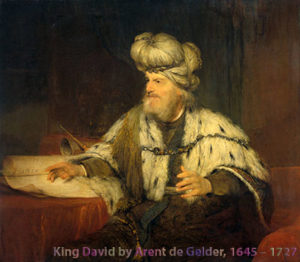Now even the first covenant had regulations for worship and an earthly place of holiness. For a tent was prepared, the first section, in which were the lampstand and the table and the bread of the Presence. It is called the Holy Place. Behind the second curtain was a second section called the Most Holy Place, having the golden altar of incense and the Ark of the Covenant covered on all sides with gold, in which was a golden urn holding the manna, and Aaron’s staff that budded, and the tablets of the covenant. Above it were the cherubim of glory overshadowing the mercy seat. Of these things we cannot now speak in detail.
These preparations having thus been made, the priests go regularly into the first section, performing their ritual duties, but into the second only the high priest goes, and he but once a year, and not without taking blood, which he offers for himself and for the unintentional sins of the people. By this the Holy Spirit indicates that the way into the holy places is not yet opened as long as the first section is still standing (which is symbolic for the present age). According to this arrangement, gifts and sacrifices are offered that cannot perfect the conscience of the worshiper, but deal only with food and drink and various washings, regulations for the body imposed until the time of reformation. –Hebrews 9:1-10
When I lived in Orlando, the city was growing by leaps and bounds. At one point I read that 400 people every day were moving to central Florida! Traffic, as you might imagine, was terrible. A massive highway expansion was being built along a route I needed to take quite often and, at one point in the project, a temporary road was built to get traffic around the construction zone. That temporary road was not built to last and was not much more than some asphalt laid down where a bulldozer smoothed off the vegetation. It didn’t last, quickly developed potholes, and wasn’t big enough to handle even a fraction of the traffic. The trees are thick around there, but every now and then as you drove along the temporary road, you could catch a glimpse of the completed sections of the beautiful huge road that was coming in due time.
That’s what the tent(s) of meeting were like. God had a master plan for how the world would be made right. This is what the writer means in verse 10 above by “the time of reformation.” Like that big, beautiful new road that could handle all it needed to, this reformation was coming. In the meantime temporary arrangements had to be made to keep things flowing. Those temporary arrangements were fallible, insufficient, and never meant to do the real work, just like that temporary road.
Interestingly, the writer relates a “first section” tent (the Holy Place) and a “second section” tent (The Most Holy Place) to two “ages”. The first section is “symbolic for the present age,” and he doesn’t mind letting us know that it couldn’t do the job. He says its purpose and activities “cannot perfect the conscience of the worshiper, but deal only with food and drink and various washings, regulations for the body imposed until the time of reformation.”
The “present age” is the time right up to the coming of the Messiah. It was a temporary thing. He wants to make sure that the readers understand that it is not the whole system. You don’t want to cling to anything there because its purpose is finished now that Messiah has come.
What has happened in Jesus is that the main new road has now been opened. Yes, the temporary road is still there, and a few people haven’t realized there is something incomparably better. They are still driving on it. It was not a bad thing and completely needed for a season, but the reformation age has come in Christ Jesus. The New Covenant is established and sins have been fully and finally dealt with. And that’s the gospel.
Come hear it preached and enacted in the Supper this Sunday!
